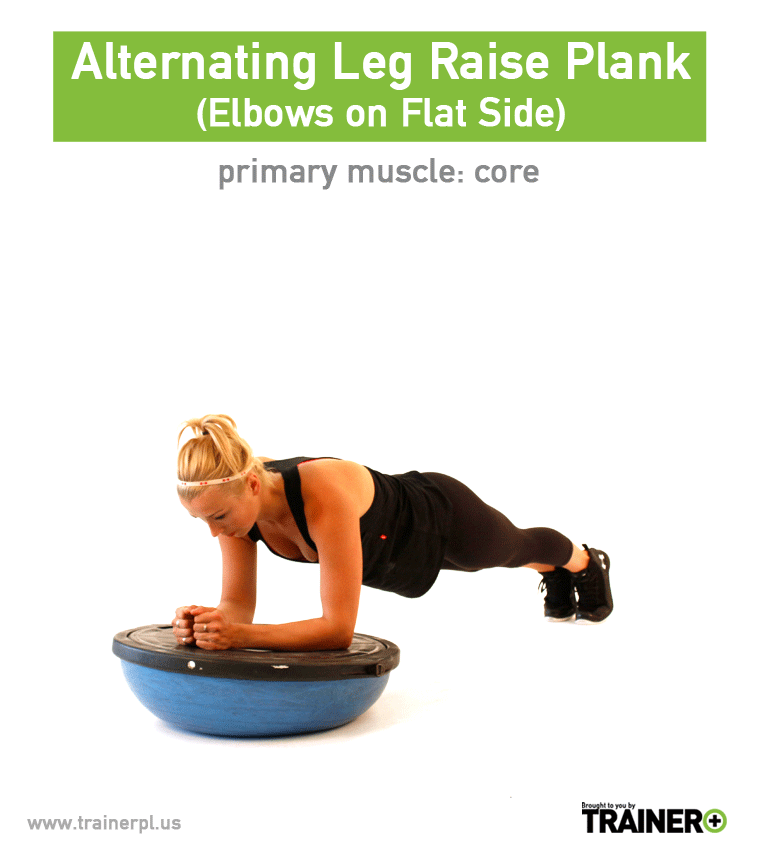UNSTABLE DYNAMIC PLANKS ON BOSU
primary muscle: core
supporting muscles: abs, low back, hips
The plank or front hold is the most important exercise for your core as it engages all of the core muscles to build both strength and stability through your whole body. Keeping a straight line between ankles, knees, hips and shoulders promotes the type of stable strength used through those joints, and more importantly, your torso, in everyday movements like sitting, standing, walking, etc. This exercise not only makes all of the muscles in your torso have to work to maintain the alignment (abs, low back, oblique, transverse abdominus), but also involves the shoulder and hip girdle to bare the weight, the other key body parts that make up the core. Adding movement or dynamicism makes all of the muscles involved have to work harder to maintain body alignment as the load shifts throughout the movement, helping increase functional strength/stability. Adding further instability into the exercise with the bosu makes the muscles that work to stabilize the joints on that end (wrist, elbow and shoulder for upper body, and ankle, knee and hip for the lower body) have to be more engaged to help balance and keep alignment, in addition to the core muscles, to help promote balance and stable strength.
Alternating Arm Raise with Elbows on Round Side
The bosu with the round side up underneath the arms, adds an element of instability that forces the shoulder girdle to have to work in concert with the rest of the core to maintain the straight body line. The round side up position of the bosu provides an environment that will not shift (bosu should stay flat against the ground and not move), but is unstable with the inflated side providing an inconsistent surface that forces increased work to stabilize. This variation puts the instability underneath the elbows, making all of the scapular and shoulder muscles have to work extra hard to maintain balance, especially with body weight shifting from side to side and the upper body weight resting entirely on one arm during the exercise.
Alternating Leg Raise with Feet on Round Side
Putting the bosu underneath your feet in conjunction with the altenrating leg raise means that your lower bodyweight is resting on one leg on an unstable surface throughout the exercise, making the muscles that support the ankle, knee and hip have to work in concert with the core to maintain balance and body alignment. With the instability under the foot and weight shifting from side to side throughout the movement, the hip girdle has to work extra hard to maintain alignment.
Alternating Opposite Arm & Leg Raise with Feet on Round Side
Raising the opposite arm and leg at the same time makes for the most difficult way to balance, now on 2 points, while still holding a straight body line. This not only makes for increased scapular and hip stability being worked, but also the transverse and rest of the core muscles in the torso to keep the body horizontal as weight is shifted from side to side. With the bosu underneath your feet for this exercise, there is an increased challenge to balance, making the muscles that support the ankle, knee and especially hip, have to work harder to stabilize and maintain body alignment. Raising the opposite arm and leg (bird-dog position) also makes for an increased challenge for the rear hip chain (low back, glute, hamstring) and muscles across the back to hold the leg and arm up.
Alternating Opposite Arm & Leg Raise with Elbows on Round Side
With the opposite arm and leg raise making for the most difficult way to balance in a plank position (on 2 points), placing the bosu underneath the elbows makes the balance even more difficult for the shoulder girdle to stabilize with that much bodyweight resting on it, on the unstable service. On the elbows (as opposed to hands with a straight arm), all of the instability has to be taken by the shoulder joint and counter balanced by the hips, with the core working to maintain body alignment while bodyweight is shifted from side to side.
Alternating Leg Raise with Elbows on Flat Side
Placing the flat side of the bosu up with round side down provides an environment that has a consistent and solid surface, but that will shift and tilt unless weight is balanced and distributed evenly throughout. For this movement, this adds an increased challenge to the shoulder girdles to share the load evenly, working in concert with the core and hips to maintain body alignment while weight is taken by 3 points at a time and shifted from side to side throughout the movement.
These exercises come from our exercise library at Trainer+, a web and mobile platform for personal trainers.
Are you digitally tracking every set and rep that your clients do with or without you?








